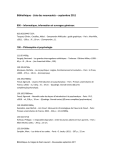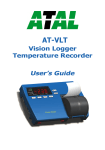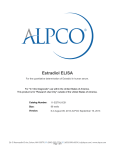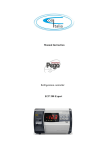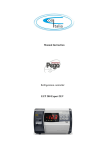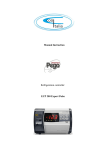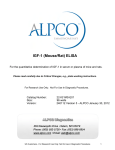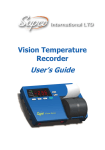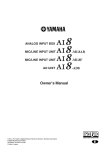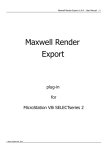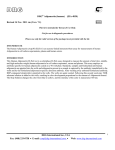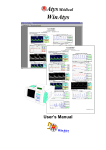Download HMW and Total Adiponectin ELISA
Transcript
HMW and Total Adiponectin ELISA For the quantitative determination of adiponectin in human serum and plasma (EDTA, citrate and heparin) For Research Use Only. Not for Use in Diagnostic Procedures. Catalog Number: 47-ADPHU-E01 Size: 96 wells Version: 3 - ALPCO October 14, 2013 26-G Keewaydin Drive, Salem, NH 03079 | P: (800) 592-5726 | F: (603) 898-6854 | [email protected] | www.alpco.com INTENDED USE The HMW & Total Adiponectin ELISA is designed for the quantitative determination of High Molecular Weight (HMW), Mid‐Molecular Weight (MMW), Low Molecular Weight (LMW), and Total adiponectin in human serum and plasma (EDTA, citrate and heparin). Upon request, a supplemental protocol can be provided for use with cerebrospinal fluid. Please note that all methodology described in this package insert for the HMW & Total Adiponectin ELISA is protected by U.S. Patent No. 7,608,405 B2, issued Oct 27, 2009. INTRODUCTION Adiponectin is a 244 amino acid protein and one of several known adipocytokines secreted by the adipocyte. Adiponectin circulates in the blood in various oligomeric complexes ranging from dimeric to “bouquet” structures of 9 or more proteins which include HMW adiponectin (12‐mer or 18‐mer).1‐3 Functions of adiponectin include protection against atherosclerosis, improvement of insulin sensitivity and prevention of hepatic fibrosis. In recent years, the relationship between these physiological actions and the multimeric structure of circulating adiponectin has attracted wide attention, and data has shown that the ratio of circulating HMW adiponectin to total adiponectin is more informative than total adiponectin levels alone.4‐6 PRINCIPLE OF THE ASSAY In the HMW & Total Adiponectin ELISA, both Total and HMW adiponectin can be measured independently on the same plate. Samples are pretreated with or without proteases7, diluted and then assayed for the different multimers of adiponectin as described below. The principle of the sample pretreatment procedure is outlined briefly here and explained in greater detail in the ASSAY PROCEDURE. 1) To measure Total adiponectin: Samples are pretreated with Sample Pretreatment Buffer (Citrate buffer + SDS) which reduces multimeric adiponectin to dimers.7 Subsequent measurement in the ELISA quantifies the amount of all multimers of adiponectin in the sample. 2) To measure HMW adiponectin: Samples are pretreated with Protease II which selectively digests LMW and MMW. The remaining HMW fraction is treated with Sample Pretreatment Buffer which reduces these multimers to dimers while also stopping the protease digestion. Subsequent measurement in the ELISA quantifies the amount of reduced HMW adiponectin but does not detect the digested LMW and MMW adiponectin. 3) To measure combined MMW + HMW adiponectin: Samples are pretreated with Protease I which selectively digests only LMW adiponectin. The remaining MMW and HMW are then digested to dimers using Sample Pretreatment Buffer which also stops the protease digestion. Subsequent measurement in the ELISA quantifies the amount of reduced MMW + HMW adiponectin but does not detect the digested LMW. 4) To measure MMW adiponectin: MMW (hexamer) concentration is calculated by subtracting the concentration of HMW from the concentration of combined MMW + HMW adiponectin. 5) To measure LMW adiponectin: LMW (trimers + albumin‐bound trimers) concentration is calculated by subtracting the concentration of combined MMW + HMW from Total adiponectin. 2/14 This ELISA utilizes an antibody “sandwich” for detection of adiponectin. The microplate wells have been coated with an anti human adiponectin monoclonal antibody, and adiponectin in the standards and pretreated samples is captured during the first incubation. Washing removes all unbound material, and a biotin conjugated anti-human adiponectin monoclonal antibody binds to the immobilized adiponectin in the wells. After the second incubation and subsequent wash step, HRP-Labeled streptavidin is added. Following a third incubation and subsequent wash step, O-phenylenediamine (OPD) is added as substrate, and the colorimetric reaction is terminated with the addition of diluted H 2 SO 4 . The intensity of the color development, i.e., absorbance value, is proportional to the adiponectin concentration in the sample. Please note that all methodology described in this package insert for the Adiponectin (Multimeric) ELISA is protected by U.S. Patent No. 7,608,405 B2, issued Oct 27, 2009. - - KIT COMPONENTS Reagent Composition Quantity Preparation Wash Buffer Concentrate Phosphate buffer (pH 7.2) 100 ml x 1 vial 10X Sample Pretreatment Buffer Citrate buffer (pH 3.0) containing SDS 50 ml x 1 vial Ready to use Dilution Buffer Phosphate buffer (pH 7.2) containing BSA 100 ml x 1 vial Ready to use Monoclonal Ab Coated Plate Anti-human adiponectin mouse monoclonal Ab coated plate 1 plate (96 wells) Ready to use Calibrator (stock solution) Human serum stabilized in sample pretreatment buffer 0.25 ml x 1 vial Concentration indicated on vial Biotin Labeled Monoclonal Ab Biotin - conjugated anti-human adiponectin monoclonal antibody 6 ml x 1 vial Ready to use Enzyme Labeled Streptavidin Horseradish peroxidase (HRP) labeled streptavidin 6 ml x 1 vial Ready to use Substrate O - phenylenediamine (OPD) 2 vials Lyophilized Substrate Buffer Citrate buffer (pH 5.0) containing H 2 O 2 15 ml x 1 vial Ready to use Stop Reagent 7.7% H 2 SO 4 15 ml x 1 vial Ready to use Protease I Protease 1 vial Lyophilized Protease II Protease 1 vial Lyophilized Protease Buffer Tris buffer (pH 8.0) 50 ml x 1 vial Ready to use High and Low Controls Phosphate buffer containing processed human serum ϮǀŝĂůƐ Lyophilized Serum Control Processed human serum 1 ǀŝĂů Lyophilized Plate Sealers n/a 3 each Ready to use MATERIALS REQUIRED BUT NOT INCLUDED • Microfuge tubes (1 ml) • Precision pipettes with disposable tips capable of dispensing 10 µl, 100 µl, 500 µl • Repeating or multi-channel pipette • Volumetric container • Volumetric pipettes 3/14 • Distilled (deionized) water • Incubator or water bath (37°C) • Microplate washer or wash bottle • Microplate reader with 492 and optional 600 ‐ 700 nm filter REAGENT PREPARATION AND STORAGE It is critical that all reagents be allowed to reach room temperature prior to use. All components are stable at 2‐10°C until the expiration date of the kit unless otherwise indicated. Wash Buffer Dilute Wash Buffer Concentrate with 900 ml of distilled water. Working Wash Buffer should be stored at 2 ‐ 10°C and is stable for the life of the kit. Sample Pretreatment Buffer To dissolve any visible precipitate, warm the solution to room temperature and stir thoroughly before use. Monoclonal Antibody Coated Plate Unused strips should be returned to the laminate bag, sealed and stored at 2 ‐ 10°C. Calibrator • The Calibrator is comprised of normal human serum stabilized in Sample Pretreatment Buffer. • To dissolve any visible precipitate, warm the solution to room temperature and stir thoroughly before use. Avoid foaming. • Create a standard curve by serial dilution as indicated in the table below. • Precipitation may occur when the Calibrator is added to Dilution Buffer, therefore, stir thoroughly. Standard Number Quantity of Calibrator Quantity of Dilution Buffer Final Concentration (ng/ml)* 1 10 µl of Calibrator stock 1,000 µl 4.8 2 150 µl of Standard 1 150 µl 2.4 3 150 µl of Standard 2 150 µl 1.2 4 150 µl of Standard 3 150 µl 0.6 5 150 µl of Standard 4 150 µl 0.3 6 150 µl of Standard 5 150 µl 0.15 7 150 µl of Standard 6 150 µl 0.075 8 0 150 µl 0 *Approximate concentrations are listed; actual concentration of the Calibrator stock is indicated on the vial label. • • Unused Calibrator should be stored at 2 ‐ 10°C until subsequent use. The Standards should be prepared just prior to loading the plate. • Diluted Standards are not stable and should be discarded. 4/14 Substrate Just prior to use, reconstitute the Substrate (lyophilized) by adding 6 ml of Substrate Buffer to the Substrate vial. The Substrate solution should be used immediately after reconstitution, and any remaining solution should be discarded. Protease I Reconstitute Protease I (lyophilized) by adding 10 ml of Protease Buffer to the vial and dissolve completely by mixing at room temperature for 15-30 min. Protease I is stable for 2 days at 2-10°C. Reconstituted Protease I is stable below -20°C for the life of the kit. Protease II Reconstitute Protease II (lyophilized) by adding 10 ml of Protease Buffer to the vial and dissolve completely by mixing at room temperature for 15-30 min. Protease II is stable for 2 days at 2-10°C. Reconstituted Protease II is stable below -20°C for the life of the kit. Low, High, and Serum Controls Reconstitute each Control with deionized water according to the Certificate of Analysis. Replace the rubber stopper and cap. Gently swirl the vial and let stand for 10 minutes prior to use. The contents of the vial should be in solution with no visible particulate matter. Store Controls in aliquots at -20°C. Reconstituted Low and High Controls are ready for use. Reconstituted Serum Control should be pretreated and diluted before use, in the same manner as the serum samples. Refer to the Control Set Certificate of Analysis for lot specific reference ranges. Sample Collection Serum or plasma samples can be used with this assay. Because the measurement of adiponectin multimers requires samples be pretreated with a protease, it is recommended that serine protease inhibitors, such as aprotinin, not be used when collecting samples. ASSAY PROCEDURE It is critical that all reagents be allowed to reach room temperature prior to use. 1) Pretreatment of samples The Adiponectin (Multimeric) ELISA allows for the independent quantification of Total and HMW adiponectin, respectively, and the indirect measurement of MMW and LMW adiponectin. Separate aliquots of sample and Serum Control must be used for each option. For example, if HMW and Total adiponectin concentrations are being quantified for the same sample, two aliquots of the sample are needed and require independent pretreatments. The pretreatment options are listed below: • Pretreatment option 1: For “Total adiponectin” assay Add 100 µl of Protease Buffer and 400 µl of Sample Pretreatment Buffer to 10 µl of sample (sample dilution = 1:51). Stir thoroughly or vortex. • Pretreatment option 2: For combined “MMW + HMW adiponectin” assay Add 100 µl of Protease I to 10 µl of sample and incubate for 20 min at 37°C. Immediately add 400 µl of Sample Pretreatment Buffer (sample dilution = 1:51). Stir thoroughly or vortex. • Pretreatment option 3: For “HMW adiponectin” assay Add 100 µl of the Protease II to 10 µl of sample and incubate for 20 min at 37°C. Immediately add 400 µl of the Sample Pretreatment Buffer (sample dilution = 1:51). Stir thoroughly or vortex. Pretreated samples are stable at 4 or 25°C for up to 2 days. Precipitate may form but will dissolve when brought to room temperature; stir thoroughly or vortex. 5/14 2) Dilution of pretreated samples Dilute pretreated samples 1:101 as follows: Add 10 µl of the pretreated sample (from Pretreatment Options 1, 2 and/or 3) to 1.0 ml of Dilution Buffer. Since precipitation may occur when a pretreated samples are added to Dilution Buffer, stir thoroughly or vortex. FINAL Sample dilution = 1:5,151. Samples must be used within 2 hours of dilution (at room temperature). 3) Assay Method 1) Plan your plate configuration. Determine how many strips will be needed and store the remaining strips in the sealed laminate bag at 2‐10°C. 2) Add 50 µl each of the Standards and diluted pretreated samples to the appropriate wells, according to the plate configuration. 3) Cover the plate with a plate sealer and incubate for 1 hour at room temperature (20‐30°C). 4) Decant the plate and strike the plate against absorbent towels to remove any excess liquid. Do not introduce absorbent materials into the wells! Wash by adding 350‐400 µl of Wash Buffer to each well (using a laboratory squeeze bottle, wash manifold, or automated plate washer); decant Wash Buffer, and strike plate against absorbent towels to remove residual liquid. Repeat this cycle twice, for a total of 3 washes. 5) Add 50 µl of Biotin Labeled Monoclonal Ab to each well. Cover the plate with a plate sealer and incubate for 1 hour at room temperature (20‐30°C). 6) Repeat wash step as described in Step 4. 7) Add 50 µl of the Enzyme Labeled Streptavidin to each well. Cover the plate with a plate sealer and incubate for 30 min at room temperature (20‐30°C). 8) Repeat wash step as described in Step 4. 9) Add 50 µl of the Substrate Solution to each well. Protect the plate from light and incubate for 10 min at room temperature (20‐30°C). 10) Add 50 µl of the Stop Reagent to each well. 11) The absorbance of each well should be measured within 30 min after the addition of the^ƚŽƉ Reagent, using a microplate reader set to 492 nm, with a reference wavelength of 600‐ϳϬϬ nm, if desired. 4) Calculations Construct a calibration curve from the Standards. The Zero Standard should be used as a blank with its average value subtracted from each well. Plot the calibration curve using a log/log scale. It is preferable to use a software program to calculate the calibration curve and to determine the concentration of the samples. The preferred curve fit method is quadratic. ‐ If a manual calculation is to be utilized, the Zero Standard should be used as a blank with its average value subtracted from each well. The standard concentrations are plotted on the X‐axis and the absorbance values are plotted on the Y‐axis. The concentrations of the unknowns are determined by plotting the absorbance of the unknown against the calibration curve. The corresponding value on the X‐ axis is the concentration of the unknown sample. Read the concentrations for the diluted samples from the calibration curve. Calculate the final concentration for the samples by multiplying by the dilution factor (1:5,151). 6/14 Calculation of each adiponectin multimer fraction: • • • • Total adiponectin = Concentration of the sample from Pretreatment option 1. HMW adiponectin = Concentration of the sample from Pretreatment option 3. MMW adiponectin = Concentration of the ssample from Pretreatment option 2 (MMW + HMW adiponectin) minus the concentration of the sample from Pretreatment option 3 (HMW) LMW adiponectin = Concentration of the sample from Pretreatment option 1 (Total adiponectin) minus the concentration of the sample from Pretreatment option 2 (MMW + HMW adiponectin). PROCEDURAL NOTES 1. This kit has been validated using human serum and plasma (EDTA, citrate and heparin). 2. Measurements of different adiponectin multimers in the same serum or plasma samples MUST be conducted on the same plate. DO NOT calculate results between different plates. 3. A calibration curve must be run with each assay. 4. Standards and samples should be assayed in duplicate. 5. If the concentration of adiponectin in a sample exceeds the highest point of the calibration curve, dilute the pretreated sample with Dilution Buffer and assay again. 6. Observe all specified reaction times and temperatures outlined in this manual. These parameters are especially important when pretreating samples with proteases. 7. If the plate is not used entirely during the first run, the remaining reagents may be stored as directed in the protocol and used once more before the expiration date. 8. Samples must be promptly added to the MoAb Coated Plate following pretreatment and subsequent dilution. 9. Remove all residual liquid completely after each step of the wash procedure. 10. Do not allow the wells to dry out or be damaged during the wash procedure. 11. Avoid carrying out this procedure in direct sunlight. WARNINGS AND PRECAUTIONS 1. The human serum contained in the Calibrator was tested and found negative for presence of the HBs antigen, HIV antibody, and HCV antibody; however, all samples should be handled carefully as though capable of transmitting infection. 2. Stop Reagent (7.7% H2SO4) is hazardous and can cause severe burns. In case of eye contact, rinse immediately with plenty of water, and seek medical advice. In case of contact with skin or clothing, rinse immediately with plenty of water. STORAGE OF REAGENTS The kit reagents should be stored at 2-10 °C DO NOT FREEZE. EXPIRATION DATE Indicated on the package REFERENCES 1) 2) 3) 4) 5) 6) 7) 8) Waki H, et al (2003) J. Biol. Chem. 278, 40352 63. Pajvani UB, et al (2003) J. Biol. Chem. 278, 9073 85. Tsao TS, et al (2003) J. Biol. Chem. 278, 508: 10 7. Pajvani UB, et al (2004) J. Biol. Chem. 279, 12: 152 62. Tonelli J, et al (2004) Diabetes 53, 162: 1 9. Kobayashi H, et al (2004) Circ. Res. 94, 27 31. Ebinuma H, et al (2006) Clin. Chim. Acta. 372, 47 53. U.S. Patent No. 7,608,405 B2, issued Oct. 27, 2009 ‐ ‐ ‐ ‐ ‐ ‐ ‐ 7/14 Performance Characteristics 1. Typical Calibration Curve Absorbance at 492 nm 10 1 0.1 0.01 0.001 0.1 1 Concentration of Adiponectin (ng/ml) 2. Sensitivity The analytical sensitivity was determined by calculating the mean ± 3 standard deviations for 20 replicates of the Zero Standard. The sensitivity of the assay is 0.019 ng/ml. 3. Reproducibility Intra‐assay (n = 8) Serum Total Sample 1 Adiponectin Mean (μg/ml) 3.98 SD (μg/ml) 0.21 CV (%) 5.4 Serum Sample 2 Mean (μg/ml) SD (μg/ml) CV (%) Total Adiponectin 9.22 0.48 5.3 Direct MMW + HMW Adiponectin 2.16 0.11 5.0 HMW Adiponectin 1.08 0.05 5.0 Direct MMW + HMW Adiponectin 6.60 0.27 4.1 HMW Adiponectin 4.53 0.15 3.3 MMW + HMW Adiponectin 5.35 0.32 6.0 HMW Adiponectin 3.45 0.20 5.7 Calculated MMW LMW Adiponectin Adiponectin 1.08 1.82 0.11 0.13 10.2 7.3 Calculated MMW Adiponectin 2.08 0.29 13.7 LMW Adiponectin 2.62 0.34 13.0 Inter‐assay (n = 8) Serum Sample 3 Mean (μg/ml) SD (μg/ml) CV (%) Total Adiponectin 7.66 0.38 5.0 8/14 4. Dilution Linearity Pretreated human serum and plasma samples, diluted per the Assay Procedure (1:5,151), were serially diluted with Dilution Buffer and assayed for Total Ădiponectin. 3.0 2.5 2.0 1.5 1.0 0.5 0.0 1/8 1/4 1/2 1 5. Spike and Recovery Varying amounts of purified human HMW adiponectin were added to a human serum samples and assayed for Total, HMW and MMW Ădiponectin. HMWĂĚŝƉŽŶĞĐƚŝŶ Observed Expected Recovery O/E Added (μg/ml) (μg/ml) (μg/ml) (%) Total Adiponectin 0.00 7.33 7.31 100 1.14 8.51 8.46 101 2.29 9.88 9.60 103 4.57 11.8 11.9 99 9.14 16.9 16.5 103 MMW+ HMW 0.00 5.69 5.69 100 Adiponectin 1.14 7.02 6.83 103 (Protease I 2.29 8.14 7.98 102 treatment) 4.57 10.8 10.3 105 9.14 16.2 14.8 109 HMW Adiponectin 0.00 3.88 3.89 100 (Protease II 1.14 5.01 5.03 100 treatment) 2.29 6.26 6.17 101 4.57 8.89 8.46 105 9.14 12.6 13.0 97 Adiponectin ng/ml ( 9/14 6. Comparison of Serum vs. Plasma Samples EDTA, heparin and citrate plasma samples were compared with serum samples obtained from four healthy volunteers and assayed for Total, HMW and MMW adiponectin. Mean Adiponectin (μg/ml) Mean Plasma/Serum (%) Sample Total Adiponectin Serum 5.84 100 EDTA plasma 5.37 93 Heparin 5.37 94 Citrate plasma 4.45 76 MMW + HMW Serum 3.69 100 Adiponectin (Protease I EDTA plasma 3.72 102 treatment) Heparin 3.77 101 Citrate plasma 3.12 83 HMW Adiponectin Serum 2.77 100 (Protease II treatment) EDTA plasma 2.56 94 Heparin 2.63 94 Citrate plasma 2.20 79 7. Freeze/Thaw Stability Four human serum samples were frozen and thawed three times and assayed for Total, HMW and MMW adiponectin. Recovery (%) Sample (n = 4) Mean (μg/ml) F/T (1X) F/T (2X) F/T (3X) Total Adiponectin 8.34 99 92 95 MMW + HMW Adiponectin 6.60 92 91 92 HMW Adiponectin 4.41 97 100 98 10/14 8. Specificity of Protease Digestion Human serum samples were pretreated per the Assay Procedure, separated by native PAGE and analyzed by Western Blot using goat anti‐adiponectin antibody. 1 669 kDA~ 443 kDA~ 140 kDa~ 2 3 Lane 1: Pretreatment Option 1 (no protease) shows detection of HMW, MMW, Alb-LMW and LMW Ădiponectin. - HMW Lane 2: Pretreatment Option 2 (Protease I) shows specific digestion of Alb-LMW and LMW Ădiponectin. Lane 3: Pretreatment Option 3 (Protease II) shows specific digestion of all multimers except HMW Ădiponectin. 9. Reference Range Forty‐seven serum samples from healthy donors were assayed for ĂĚŝƉŽŶĞĐƚŝŶŵƵůƚŝŵers. Data are presented as Total, HMW, MMW and LMW Ădiponectin and as ratios of the individual multimers to Total Ădiponectin (HMWR, MMWR, and LMWR). Male n = 27 Total HMW MMW LMW Mean (µg/ml) 4.30 1.62 1.15 1.54 SD 1.76 1.02 0.38 0.50 HMWR (%) MMWR (%) LMWR (%) Mean 34.5 27.9 37.6 SD 11.1 5.41 7.78 Total HMW MMW LMW Female n = 21 Mean (µg/ml) 6.62 3.24 1.70 1.68 SD 3.04 Ϯ.ϭϯϬ͘ϲϴϬ͘ϰϲ HMWR (%) MMWR (%) LMWR (%) Mean 44.5 26.7 28.8 SD 12.3 4.47 10.3 11/14 } Human Plasma } Human Serum } Human Plasma } Human Serum } Human Serum } Human Plasma 10. Specificity of Antibodies In order to demonstrate specific reactivity to the intact multimeric forms of adiponectin, human serum or plasma was separated by native PAGE and analyzed by Western blot using the ELISA capture ab (A), detection ab (B) or a goat anti-human adiponectin polyclonal ab (C). ←HMW 669 kDa→ ←MMW (Hexamer) 443 kDa→ ←Albumin binding‐LMW (Trimer) LMW (Trimer) 140 kDa→ 66 kDa→ (A) (B) (C) 11. Cross-reactivity This ELISA does not cross-react with mouse, rat, rabbit, goat, sheep, pig, horse or bovine samples. No signal was detected when cross-reactivity was tested for human Resistin, Leptin, TNF-a, and IL-6 at concentrations up to 100 ng/ml. 12/14 12. Reduction of Multimeric to Dimeric Adiponectin with Sample Pretreatment Buffer +/‐ Boiling Human serum and plasma were incubated with Sample Pretreatment Buffer, separated by SDS-PAGE and analyzed by Western blot using the capture ab (A) or the detection antibody (B). The pretreatment conditions were as follows: (1) 50 mM Tris-HCl buffer (pH 6.8) containing 2% SDS without boiling (2) 50 mM Tris-HCl buffer (pH 6.8) containing 2% SDS with boiling (3) Sample Pretreatment Buffer (from the kit) without boiling H.S Serum H.P Plasma Serum (1) (2) (3) (1) (2) (3) A Plasma (1) (2) (3) (1) (2) (3) B 200kDa→ 116kDa→ 66kDa→ ← Dimer 42kDa→ 30kDa→ 13/14 Assay Procedure: Short Form Pretreatment of samples Serum or plasma ‐ 10 μl Pretreatment for Pretreatment for Pretreatment for “Total‐adiponectin”assay combined "MMW + HMW adiponectin assay" HMW adiponectin assay Protease Buffer Protease I Protease II 100 μl 100 μl 100 μl Å Protease Digestion Æ Incubate 20 min at 37 ◦C. Sample Pretreatment Buffer ‐ 400 μl Dilute pretreated samples 1:101 with Dilution Buffer. Proceed to Assay Method within 2 hours of dilution. ______________________________________________________________________________________ Assay Method Standards and diluted pretreated samples ‐ 50 μl Monoclonal Ab Coated Plate ‐ Incubate 1 hour at RT. Wash 3 times, 350‐400 μl per well. Biotin Labeled Monoclonal Ab ‐ 50 μl Incubate 1 hour at RT. Wash 3 times, 350‐400 μl per well. Enzyme Labeled Streptavidin ‐ 50 μl Incubate 30 min at RT. Wash 3 times, 350‐400 μl per well. Substrate Solution ‐ 50 μl Incubate 10 min at RT. Stop Reagent ‐ 50 μl Measure absorbance at 492 nm within 30 min after adding Stop Reagent. 14/14














